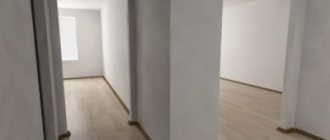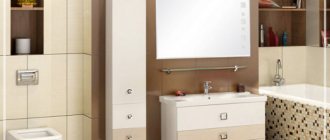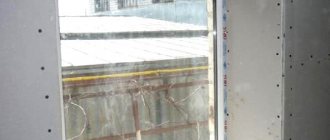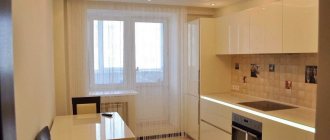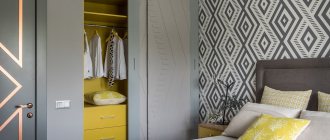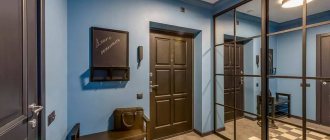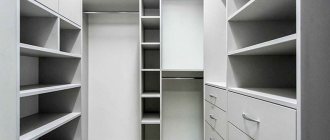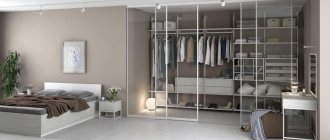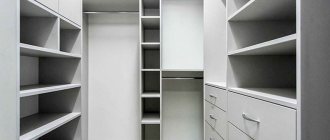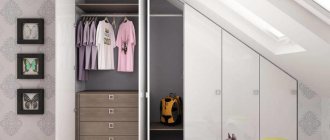A dressing room is a specially designated space in a room where items of clothing will be stored. Typically, dressing rooms are made in the bedroom, where people most often change clothes, but it can be built in another convenient place. A dressing room made of plasterboard saves not only space, but also money.
When there are too many clothes and they are scattered literally everywhere, then even a small dressing room of 3-4 square meters saves the situation. Using drywall to create it, you can significantly save on building materials.
Requirements for a dressing room
It’s easier to make a plasterboard dressing room without an open top.
Before you dive into work, you need to understand what a dressing room should be like. Everything is thought out in order to organize the storage of clothes and shoes, as well as to have quick access to them. It’s clear that you need to save space as much as possible. Let us immediately note that a dressing room is made with your own hands from plasterboard in large rooms. There is no point in creating it in a 2 by 3 meter room.
You may not need to do anything at all, because often closets are converted to store clothes. But if there is no pantry, then you will have to create everything yourself.
There is no point in making a dressing room less than 1x1.5 meters. If it is even smaller, then no layout will help to properly store things in it. The more things, the larger the area. If you need to store a lot of dresses, then the space for the dressing room should correspond to this volume. The fact is that long clothes take up height, which means there will be fewer shelves and, accordingly, less space for other clothes or shoes.
What needs to be calculated before starting work on organizing a dressing room?
There are several things that need to be considered before you begin organizing your closet. These include:
- Location. This has already been addressed.
- Square. It’s good if you can allocate 6 square meters. Minimum – 2 square meters. When deciding on the area, think about what you will put in the dressing room. For example, if only casual clothes and shoes, then a minimum of 2 square meters will be more than enough.
- Door. It should not create obstacles. Choose a coupe type door (sliding in different directions).
- Designs for storing clothes and shoes. They should be attached wisely and not in a chaotic manner.
Choosing a place in the apartment
Since there is no convenient storage room, you need to find another suitable place. A plasterboard wardrobe in the bedroom is an obvious option. Let's look at all the possible places.
If properly decorated, the dressing room in the bedroom will be invisible
- Bedroom. Usually has a large area and is an ideal option. Things are always at hand and in quick access.
- Pantry. A very economical option if available. Problems arise only with dimensions (they are predetermined) and ventilation.
- Dead end of the corridor. If there is a long corridor that ends in a dead end, then this is an ideal place for a plasterboard dressing room. But such situations are extremely rare.
- Hall. If the apartment has a hall, then it always has the largest area. You can also make a dressing room in it, but not everyone has such a room.
- A balcony or loggia can be a good place for a plasterboard dressing room. However, for this they must be insulated. It is also necessary that there is heating there, otherwise in winter things will simply deteriorate. You will have to use moisture-resistant drywall and insulation between the sheets.
Finishing: dressing room in the niche of the room
You have installed the frame and covered it with drywall. When everything is ready, we begin finishing. The decoration of the dressing room in the niche of the room can be different. First you need to seal the seams between the sheets and the fastening points. You will need to putty them. After the putty has dried, sand the surface to get rid of excess putty. When everything is ready, apply a layer of primer with a roller to the plasterboard structure.
If the room is made in high-tech style, then an excellent option for separating the dressing room and the room is to use sliding doors
The final stage is the decorative finishing of the dressing room in the niche.
As finishing you can use:
Which is better: heated floors or radiators?
Warm floorBatteries
- Paint;
- Wallpaper;
- Mirror coating;
- Drywall sheets with printed images.
Finishing is easy and quick with your own hands. The main thing is that the design of the dressing room fits into the interior of the room and is in harmony with it.
Layout features
Before starting work, you need to find out how much material is needed for the job. To do this, you need to understand the layout. Only by solving this issue will it be clear how many sheets of drywall, screws, profiles and other things are needed.
If nothing limits you in the layout, then it might make sense to order a huge wardrobe or hire workers to do everything. If the financial issue is acute, then every detail should be thought through. A DIY dressing room made of plasterboard will help you save money if you think economically.
Corner dressing room is an economical option
The first step is to understand how much free space there is. If it is possible to allocate 6-8 square meters, then this is ideal. If not, then you will have to get out. After determining the footage, you need to decide how many compartments will be allocated for shelves, and how many for clothes hangers. Usually they make 1-2 shelves at the bottom, then on top there is space for hangers with clothes, and above that there are 1-2 more shelves for other things. And this is done in several sections.
A characteristic feature of the dressing room is the presence of doors. They need to be designed so that it is convenient to enter. Poorly designed doors reduce the usable area of the room.
To summarize, we can say that it is necessary to know in advance the area of the dressing room, as well as its layout. Ideally, draw a sketch where everything will be provided. This sketch will be needed in the work to create a frame from metal profiles and cover it with sheets of plasterboard. Therefore, you need to know where the opening for the door will be created, where the fastenings for the bar will be, and where the shelves will be attached.
Why do you need a dressing room in the bedroom?
By replacing the closet in the bedroom with a full-fledged dressing room, you can significantly save space not only in the bedroom, but also in part of the hallway and other rooms. A dressing room is a multifunctional room, a kind of storage room in which you can store many things.
Namely:
- Clothes;
- Linen;
- Toilet accessories;
- Cosmetics;
- Shoes;
- Outerwear;
- Bags;
- Cosmetics, etc.
In many apartments, the space is not enough to store the same supplies of household chemicals and other household items, so often all this is placed in the dressing room.
Many people dream of a room like this, but not everyone can build it. With drywall it is quite possible to do this yourself, investing a minimum of costs.
So, where do you start building a plasterboard closet in your bedroom?
What to consider in the project
Constructing a dressing room from plasterboard is much faster if you have a project or sketch. In the project, you need to designate in as much detail as possible both the entire dressing room and each section separately. You need to be especially careful when drawing designs with a beveled corner. What a dressing room layout might look like:
The standard depth of the shelves is 50 cm (no longer required), and the distance between them does not exceed 40 cm. The space parameters for the clothes rail depend on the type of clothing. Perhaps you will only have shirts and jackets there, or perhaps you need to provide space for evening dresses.
In the project, we do not forget about the thickness of the walls, otherwise it often turns out that the dimensions turn out to be smaller than planned. The thickness of the walls consists of the width of the profile used and the thickness of the plasterboard with which it is sheathed.
Often a dressing room made of plasterboard is left without doors. At least they are not taken into account in the project. The door width should be 80 cm (in extreme cases - 60 cm). Many people get into real trouble with them. Doors made of plasterboard or other material are always a problem area in the dressing room due to the complexity of their installation. Some people use a sliding door system, others choose a swing design. Some people refuse doors altogether to avoid fooling around. Everyone makes this choice independently.
Conclusion
A dressing room is not a luxury, but a very rational design for storing all your things; you can do without closets, which will make your rooms more stylish and modern. The video in this article will help you understand some of the nuances in more detail, and if you have questions on the topic, write them in the comments under this review.
Did you like the article? Subscribe to our Yandex.Zen channel
September 28, 2016
Plasterboard systems, Design, Design of other rooms
If you want to express gratitude, add a clarification or objection, or ask the author something, add a comment or say thank you!
Preparation of materials, tools and other devices
When all the preliminary work has been completed and there is an understanding of how much of what is needed, then it’s time to move on to purchasing. For work you will need the following consumables:
- ordinary drywall 12.5 mm thick. It is necessary to calculate the required area in advance and convert it into the number of sheets, taking into account cutting;
- metal profile 50x50 mm. The design is quite simple and without additional burdens, so you can get by with one type of standard profile;
- metal screws 25 mm or 35 mm for fastening drywall;
- dowels for attaching profiles to the floor and ceiling.
Since the plasterboard wardrobe will need finishing, primer and putty will also be required. In addition, you will need the following working tools:
- knife for cutting drywall sheets;
- metal scissors for cutting profiles;
- cutter for fastening profiles together (you can use small metal screws);
- screwdriver and drill for screwing in screws and creating holes for dowels;
- roller with spatula for primer and putty;
- level.
Some advise for some reason to insulate the dressing room, but if it is in the bedroom, then there is no point in this. Even in other heated rooms, insulation will only be an additional expense that will not bring any benefit. An important point is lighting. It is not necessary for small areas, but for a large dressing room light is necessary. Therefore, you should purchase the necessary wires and lighting fixtures.
This is a more or less standard list of what is needed, but it can be expanded. For example, hinges, door handles, sliding door systems, etc. may be required.
Installation: dressing room made of plasterboard
Any woman will be glad to have a dressing room in her apartment. You can do it yourself. You don't need any special education to do this. You must be able to apply your skills and abilities, following the developed plan. You can make a dressing room from plasterboard in a niche in any living space. The main thing is that it is the right size and fits into the interior of the apartment.
Drywall is a modern and suitable material for making a dressing room. The sheets have a strong structure and are easy to care for. They are not expensive. It is possible to buy this material at a hardware store.
First you need to develop a wardrobe design, then make a drawing with dimensions. To do this, you must decide on the location of the room for things and take measurements.
Buy all the necessary materials and tools for the job.
Drywall is great for niches because it has a long service life and attractive appearance
At the first stage, transfer the markings to the floor, walls and ceiling. This is necessary so that the dressing room is installed as accurately, correctly and evenly as possible.
To make a dressing room in a niche you will need materials and tools:
- Drywall sheets;
- Metal profiles;
- Roulette;
- Metal scissors;
- Magnetic level;
- Hammer;
- Self-tapping screws.
You can connect the profile with self-tapping screws or a cutter. Using a cutter, you can build a structure faster.
After we have taken measurements and put marks, we begin the main work. We attach the metal profiles to the wall and to each other. We create a reliable frame from profiles, based on the developed project.
At the second stage, we cut the sheets of drywall to the required size. We attach them to the frame with self-tapping screws.
If the design of the dressing room has a door in a niche, then we make it separately and fasten it on hinges. If you have sliding sashes, then install the profile at the top and bottom. We insert two doors into it, which will move using wheels.
Assembling a frame from a metal profile
This is what a simple frame for a dressing room looks like.
Now it’s time to talk about how to make a dressing room from plasterboard with your own hands. You need to transfer the drawing to the wall, floor and ceiling so that you can see where to attach the profiles. The frame will be assembled from a metal profile, so you need to mark everything correctly. Since the dimensions of the structure are small, you can manage it using a level, tape measure and pencil. The profile is used instead of a ruler.
The places where the profile will be attached to the wall are marked on the floor, wall and ceiling. A step of 40-60 cm is quite enough. In these places, the surface is drilled for dowels (dowels themselves measuring 6x40 mm are quite suitable). The profile is applied to the surface and holes are also drilled in it, and then it is secured with driving screws. This is how the profile is attached in all places where it touches the wall, ceiling or floor. Some people use a rack profile for these purposes, and the rest is assembled into a structure from guides. Others prefer to carry out all work with a guide profile. Neither option is wrong.
Before installing profiles to the wall, ceiling and floor, it is advisable to lay sealing tape at the fastening points. It is used for additional sound insulation and reduces the level of vibrations of the entire structure. When things are put on a shelf, doors are closed or coats are hung up, there will be much less noise.
When assembling the box, it is important to take into account the space under the door so that the profile does not run along the floor. Since the dressing room is made of plasterboard, additional reinforcement of the frame in the doorway may be required. Also, the entire frame is reinforced around the perimeter with the help of jumpers, which are inserted into the assembled box in increments of 60 cm. The racks are attached to the frame with metal screws 25 mm long. You need to make sure that one of the posts goes through the place where the tramp rod is attached.
If the dressing room already has an outlet, then great. If not, then you need to think about how to bring it through profiles. You should also do the wiring at this stage if there are several light sources in the dressing room. If you also make shelves from plasterboard, then it will be a very labor-intensive dressing room. And such shelves take up a lot of space. But built-in partitions for dividing the dressing room into sections can come in handy. They are made in the same way as the base frame.
Construction of the structure
So, you have thought through the location of the dressing room, determined how much area you are ready to allocate and know exactly the dimensions and configuration of the future structure. This information is sufficient to begin work. Do them in the correct order, then you will not have miscalculations and shortcomings due to the fact that you did not do what was needed.
Design
The most important step, if you make a mistake here, you will get so many problems in the future that a situation may arise that it will be easier for you to demolish the structure and make a new one than to eliminate the shortcomings caused by ignoring the planning process.
Let's figure out what needs to be done:
- First of all, you need to draw a sketch of the compartment in which the dressing room will be located . If it is a niche or an old pantry, then everything is simple: you need to take measurements of the actual area and transfer the results to paper. If you are finishing part of the room, then you need to carefully plan the size of the structure down to the centimeter and determine its configuration; the example shows a complex but practical option with a beveled corner;
Mark the outlines of future walls in the room to visually see how much space it will take up
- Next, you need to determine the optimal sizes of racks, shelves and compartments for storing outerwear. The depth of the shelves should not be more than 50 cm, the distance between them 30-40 cm, for bulky items the height should be 10 cm greater than their size . Compartments for outerwear are calculated based on their number and length of clothing; usually their height is about one and a half meters. The minimum width of the passage should not be less than 80 cm;
- Based on all the above information, you can create a rough sketch of the future storage system. If you cannot decide on its configuration, then look at ready-made solutions on the Internet and take a separate option as an example, or assemble your project based on several sketches you like; finding a ready-made solution for certain sizes can be difficult;
An example of a competent sketch for a rectangular room measuring 2.9x1.6 meters
- Don’t forget to take into account the position of the door and its size; this can be either a regular swing version or a sliding design, as in sliding wardrobes . To implement it, you don’t need to be a pro - there are ready-made kits on sale with guides and rollers that are suitable for ordinary door leaves and are installed according to simple instructions. The price of such a set is around 2-3 thousand, depending on the quality;
This is what this mechanism looks like; it’s perfect for a dressing room
- In order for all your racks to be strong and reliable, they need to be very well secured to the wall. Having a ready-made project will help you determine in which places the storage structure will be fixed; there it is worth laying additional frame elements, if necessary. By doing so, you will make your life easier and get rid of the headache of how to attach the shelving without breaking the wall.
If you have two loggias, then one of them can be used as a dressing room, so you can deal with the trash by placing it in closets, and additionally get a full-fledged wardrobe without reducing the living space at all.
The option using a loggia will require minimal investment in refurbishment
Necessary materials
Now let's figure out what is needed to carry out the work, let's start with the materials for arranging the partition:
- The PS-2 rack profile is 50x50 mm in size, it is quite enough to build a strong wall , and we do not need a large thickness, since a thick partition takes up extra space. We don’t need special heat and sound insulation; in the dressing room these indicators have absolutely no meaning. In the kit you need to purchase a guide profile, it is attached around the perimeter and sets the position of the future wall;
The PS-2 profile is an ideal solution for constructing a partition
- To cover the structure, you need plasterboard with a thickness of 12 or 15 mm, choose for yourself. In fact, there will be no load on the structure, and the humidity in the room should not rise above normal. Therefore, there is no point in spending money on moisture-resistant drywall or gypsum fiber boards;
- The internal cavity of the partition will be filled with mineral wool, this is necessary in order to create a minimum thermal insulation layer that will allow maintaining an optimal microclimate in the compartment. And the walls won’t ring when hit, like an empty bucket, which is also important;
- To finish the surface we will need putty, mesh for seams and primer to strengthen the base after work. As a finishing coat, I recommend using washable paint; this is the simplest and most inexpensive option, which is both reliable and attractive, because you choose the best color yourself and can change it from time to time;
- Lighting is also a must, so don’t forget to purchase wires, a switch and an outlet. It is best to use LED lamps, they are economical, safe and very durable;
LED lighting for the dressing room is not only practical, but also beautiful
- Don’t forget about the door and the set of fittings for it; it all depends on what type of structure will be used. As for the door leaf, choose an option that suits the interior; you don’t need expensive products, and there won’t be any stress on the structure.
As for racks and shelves, it all depends on the project you choose. The cheapest and most popular option is chipboard, which is good because you can choose any color and texture. Another plus is that if you have a ready-made design project in hand, then they will cut the material into the required pieces, you don’t have to worry about sawing, you will get elements of an ideal shape.
Naturally, a set of fittings is also purchased, which can be selected in the same place as the chipboard.
Chipboard is an excellent option for constructing a storage structure
At one time I assembled shelves from cut-up material, and I liked the process for its simplicity and high speed of completion of the work. The main thing is to have an assistant who will hold the elements while fastening.
Frame construction and wiring
Now we will figure out how to make a dressing room from plasterboard, the work begins with the construction of the frame, and this process consists of the following steps:
Construction of a frame is a simple but responsible process
- First you need to use a level to mark the future position of the guide profile . You can mark using a construction pencil, and for better visibility, stick masking tape along the line in some places. To quickly and accurately apply markings, you can use a tapping cord; it is very convenient to use;
The chopping cord must be pulled away from the surface and released; the chalk will leave a straight line
- Then you can start drilling holes for the dowels; it is best to attach a profile and make markings along its holes so as not to drill holes in it either. For fastening, quick installation dowels 6x40 or 6x50 mm long are used. Accordingly, the diameter of the drill should be 6 mm, and the working length should be at least 10 mm longer than the dowel;
- The profile is fastened quickly and reliably: dowels are inserted into the holes, after which an impact screw is driven in, which pushes the structure into the concrete, ensuring reliable fixation. If your floor is wooden, then you don’t need to drill anything, you can simply screw the guides using ordinary wood screws 25-30 mm long;
The profile is attached to wood, chipboard and other soft materials with self-tapping screws
- Then you need to install the vertical posts; to do this, they are inserted into the guides in increments of 60 cm and fixed with special screws called bugs. If you have a corner in your structure, then you need to strengthen it by installing and connecting two profiles, this will make the wall much stronger;
Corners should always be reinforced for reliability.
- At the location of the doorway, the structure should be strengthened with additional lintels. Also, jumpers are placed throughout the entire structure, do not forget about the location of shelves and racks and place horizontal elements at the desired height so that you can later attach to them.
The finished frame must be motionless and not bend when pressed.
When the profile structure is ready, it’s time to start laying the wiring; it can be laid directly inside the frame in a special corrugated hose , and as for the walls, you need to make grooves in them. If you have a good finish and you don’t want to spoil it, you can put the wire in a box, it will still hide behind the shelves, and the dressing room will look neat and attractive. Wires are routed to the locations of lamps, switches and sockets.
Holes are drilled in the profile and corrugated wires are pulled through, this is safe and reliable
Sheathing of the structure and its putty
When the frame of the future wall has been built, you can begin covering it; the instructions for doing the work yourself are as follows:
- Fastening drywall is quite simple: the sheet is placed so that its edges are located on the profile . Next, you need to use self-tapping screws with a fine pitch of 3.5x25 mm to attach the material to the profile, the fastener spacing is 20 cm, you need to tighten the hardware so that the cap does not stick out above the surface, but you shouldn’t recess it too much, since the sheet may crack or break ;
- Where a whole sheet does not fit, it is necessary to cut pieces of the required size and secure in the same way. Try to join the elements as best as possible so that there are no wide gaps between them, which will have to be sealed later;
- When the structure is already sheathed on one side, you can begin work on the other side. In this case, before attaching the sheets, mineral wool is placed in the internal space of the frame, which is cut into pieces of the required size. Otherwise, the work is carried out according to the same algorithm as in the points described above;
As a result, you should have a multi-layer structure with mineral wool inside
- Putty begins with gluing all seams with self-adhesive sickle tape, which strengthens the joints and avoids the appearance of cracks on the surface . Also, before starting work, check whether all the screws are recessed below the plane; to do this, simply run your hand over the surface; if there are no protrusions, then everything is fine;
Serpyanka reinforces sheet joints
- The putty is first applied to all joints, and the screw heads are also covered. If you have corners in your design, then, in order for them to be perfectly smooth and durable, use a putty corner, which is placed and covered with the compound;
- The second layer is applied to the entire surface in a thin layer, after which you need to wait for it to dry and rub it with sandpaper. If there are still many flaws on the plane, you will have to go through the putty again to get a smooth surface;
- After sanding, the surface is coated with a strengthening primer, which will reduce the absorption of the base and improve paint adhesion. Painting is done in two layers, the easiest way is to use a roller, it allows you to carry out the work quickly and efficiently.
Painting gives our dressing room a finished look
Installation of door and storage system
After finishing, you can begin attaching the door. If you use ordinary hinges, then a box is placed in the opening and everything is done as with ordinary canvases. But if you have a sliding structure, then the work is carried out as prescribed by the instructions, which always come with the kit. It has detailed diagrams, so completing the job will not be difficult.
As for the storage structure, the list of work depends on the configuration of the system; I will give some tips on assembling products from chipboard:
- Shelves can be attached to vertical posts either using special furniture confirmation screws or using corner shelf holders . The first option is more reliable, but requires drilling holes with a special drill, the second is simpler, but the strength of the connection is somewhat lower;
The confirmant firmly tightens the perpendicularly located chipboard sheets, and the fastening point is closed with a plug
- When you assemble a cabinet from cut pieces, do not forget to glue the ends that face outward . To do this, a special edge is used, which must be heated with an iron so that the adhesive composition melts and firmly adheres to the chipboard; the work is not difficult, but requires care; I personally touched the iron several times the first time and got burned;
Iron and pressure roller allows you to securely glue the edge
- To construct rods for hangers, purchase a furniture pipe of the required length, which is attached using flanges; this is a simple and reliable design option. The main thing is to use a pipe with thicker walls so that it does not bend under the weight of heavy things;
Using flanges you can easily fix the pipe in the required place
- If you decide to install drawers, then they need to be assembled according to the diagram shown below , it is best to use fiberboard as the bottom, and the side walls can be made of uncoated chipboard; only the outer element, which is attached to the front, will be visible. On the sides it is necessary to install guides, the length of which depends on the depth of the drawers;
Drawers allow you to conveniently store small items
- There is no point in installing doors in the dressing room, which simplifies the work; an open system is more convenient and allows you to quickly find the things you need.
This module will allow you to place a lot of things
Plasterboard covering and finishing
The plasterboard is fastened with self-tapping screws in increments of 15-20 cm.
Sheathing the entire structure with plasterboard begins from the inside. Where possible, whole sheets are used, and in other places they are trimmed. It is important that the edges of the sheets fall on the profile, otherwise their fixation will be problematic. Self-tapping screws 25 mm long (maximum 35 mm) are used for fastening.
Drywall must be screwed in all places where it comes into contact with the profile. The screw heads should not stick out; they should be slightly deepened so that the surface remains smooth.
When a plasterboard dressing room is lined from the inside, you need to provide space for sockets, lamps or wire outlets. Depends on the project. A cavity is formed between the sheets of drywall (inside and outside the dressing room), in which it is convenient to route wires for future lighting. Some people carry out additional insulation and sound insulation, but for a dressing room in the bedroom this is clearly a waste of time and money.
When all the sheets of drywall are secured, you need to putty all the joints and screw heads. The joints are additionally strengthened with reinforcing tape so that they do not cause cracks in the future. It is also necessary to putty all corners. Trimmed seams must be primed before puttying to prevent the mortar from falling off. After puttying, the surface of the dressing room will become uniform and ready for finishing.
Dressing room before and after finishing
Further work depends on the type of finishing coating chosen for the dressing room. Its walls can be simply painted or covered with wallpaper. Some people add additional decorative panels or plywood. Some people like covering walls with mirrors.
Drawing up a design for a plasterboard dressing room
First of all, it is important to determine for yourself the dimensions of the future dressing room, its shape and capacity. The choice of location and subsequent steps will depend on this. At the same time, we should not forget about the area of the bedroom itself, so that the dressing room does not end up taking up most of the room. The shape of the dressing room can be square, triangular or rectangular, in the form of a huge closet covering the entire wall.
When drawing up a bedroom design project, it is important to choose the right place for the future dressing room.
In order to choose the right dimensions of the dressing room, it is important to determine its purpose. It can be used simply to store things, like a closet, or as a dressing room.
How to choose the size of the dressing room:
- If the dressing room is planned only for storing things, the distance from the facade to the wall can vary from 0.5 to 1.2 m;
- In the case of a locker room, its width should not be less than 1.5 m.
The most convenient option is a square-shaped dressing room. In it, everything is in quick access, and there is space for movement. Such a dressing room can be equipped with a mirror and a dressing table.
A drawing of all shelves, brackets and pull-out sections for storage should be drawn up in advance so that you can save on shelving and attach it all directly to the wall frame.
There is no specific algorithm for drawing up a dressing room plan: everyone plans the room in accordance with their needs and preferences. But before purchasing materials and starting installation, it is advisable to have a detailed drawing with dimensions and parameters. It will help you save on finances and avoid mistakes during construction.
Finishing touches
In essence, the creation of a plasterboard dressing room is complete. However, there are a few more points worth paying attention to.
In particular, we are talking about the trampoline rod. It will bear the maximum load in the dressing room, so high-quality fastening should be carried out. It is best when the rod is attached not only to the drywall, but also to the profile, which is part of the frame. Then the entire load will go not to the gypsum board, but to the profile, which is much more reliable.
The question of doors also remains open. The easiest way is to purchase sliding doors with a special system so as not to do everything yourself. This option will be optimal in terms of saving space. It is worth thinking about ventilation. It's not very good when everything is clogged.
As a finishing coating, it is recommended to use wallpaper that matches the room. Gluing them requires minimal preparation of the drywall. And in this case, the dressing room made of plasterboard will merge with the room.
As for the different shelves, they can be made from different materials. These can be plasterboard shelves, but you need to know how to make them. If there are too many shelves, the work will be protracted. You can learn how to make shelves in a dressing room from the video.
Installation of door and storage structures
Once the finishing is complete, we begin installing the doors. There are several options for installing the door structure:
- Hinged doors are installed using conventional hinges. Before attaching the canvas, a box is installed onto which the hinges are screwed;
- If you purchased a sliding door, its installation is carried out based on the manufacturer's instructions. Following the instructions, it will not be difficult to install the sliding door yourself.
The contents of your dressing room will depend on which system you choose. Usually ordinary chipboard is used, and the work is done like this:
- The shelves are fastened with the help of corners that hold the shelves, or with the use of confirmations. The second option is more reliable, but you will have to spend more labor on it - drill special holes in the material for the comfermat;
Options for sliding doors for a dressing room - Also, for the aesthetics of the structure, it is worth gluing all the ends of the shelves with edge tape. The work is simple, just apply the edge to the edge of the shelf and heat it with an iron;
- The rods are made from furniture pipe, which can be bought in a store of the required length. Drill a small recess, insert flanges into them and hang the pipe.
You can install drawers that are assembled from chipboard and plywood, which is installed on the bottom of the drawer. There are a lot of photographs of various types of similar structures on our website.
Dressing room in the bedroom made of plasterboard: how to make it cheap and easy
The most convenient option is a square-shaped dressing room. In it, everything is in quick access, and there is space for movement. Such a dressing room can be equipped with a mirror and a dressing table.
To build a dressing room, you will need a set of tools for working with drywall, as well as spatulas, a hammer drill, a drill, metal scissors, an angle grinder, etc. Depending on how full the dressing room is, you may need different materials. If all sections are made to order, then you only need to equip a room for them. First, markings are made on the wall in accordance with the drawing: the profile will be mounted along it.
Next, the supporting strip is attached using dowels. It must be installed strictly according to the level, since the quality of the entire structure will depend on this. A rack profile is inserted into the grooves of the supporting profile - later shelves, crossbars, drawers and other storage systems will be attached to it (using self-tapping screws).
First of all, it is important to determine for yourself the dimensions of the future dressing room, its shape and capacity. The choice of location and subsequent steps will depend on this. At the same time, we should not forget about the area of the bedroom itself, so that the dressing room does not end up taking up most of the room.
The shape of the dressing room can be square, triangular or rectangular, in the form of a huge closet covering the entire wall.
Making a dressing room from plasterboard with your own hands
As an example, we consider a room measuring about 20 square meters. m., which is a passage. During the major renovation, it was decided to isolate it (make it non-passable, with its own door) and separate a part for the dressing area. The size of the dressing room was 3 square meters. m., the remaining residential part is 15 sq. m. m, with 2 sq. m. became a corridor. The initial ceiling height was 2.5 m; after installing the plasterboard suspended ceiling, the height decreased to 2.4 m. The photo shows that along with the structure for the dressing room, a decorative ceiling element for the room was erected, but it is not considered in this article. Frame The future walls and ceiling are ready, you can start attaching the plasterboard sheets.
In this example, sheets of size 150 by 60 cm, 12.5 mm thick are used. They are no different from the usual large sheets, but they can be brought from the store in any passenger car and fit in a small elevator. In addition, they are convenient for one person to attach.
Are you wondering how to make a dressing room in your room, but don’t know what material to choose for the walls? To build a dressing room in an apartment, lightweight plasterboard partitions that you can build with your own hands are suitable. The article shows photos of the process of building the walls and ceiling of a dressing room measuring about 3 square meters. meters.
The width of the PN and PS profiles is selected depending on the desired thickness of future partitions and can be 4.2, 5, 6.6, 7.5, 10, 12.5, 15 cm.
How to make a dressing room from plasterboard with your own hands: steps
To begin with, markings are made on the wall, in accordance with the drawing: the profile will be mounted along it. Next, the supporting strip is attached using dowels. It must be installed strictly according to the level, since the quality of the entire structure will depend on this. A rack profile is inserted into the grooves of the supporting profile - later shelves, crossbars, drawers and other storage systems will be attached to it (using self-tapping screws).
Drywall sheets must be cut according to the drawing so that they have the correct size and shape.
The gypsum board is attached inside the frame using self-tapping screws. This must be done with caution so as not to push through the material. All communications should be thought through in advance (heating pipes, electrical wiring, etc. can pass through the dressing room).
Further actions are performed according to the following algorithm:
- In the case of soundproofing in the dressing room, mineral wool, foam plastic or other insulating material is laid on the outside of the frame.
- Also, the dressing room needs electrical wiring. A couple of sockets and a few eyes for lighting in the room are simply necessary. The wiring is laid under the plasterboard, lamps and socket boxes are easy to install in the material.
- The next stage is covering the frame from the outside with plasterboard. When covering the frame, you should immediately take into account the location of doors, decorative elements and other details on the gypsum board wall.
- Next is installing the door. For a rectangular or triangular-shaped dressing room, the best option would be a sliding door, and a square room can be separated with a swing door. To save on door installation, you can attach a plastic cornice along the width of the opening and cover it with textiles.
- The last stage involves sealing the drywall joints and preparing the surface for finishing.
In terms of design, a good option would be not to highlight the dressing room from the general background of the bedroom, and to decorate its walls in the same way as the room. This method will organically fit the dressing room into the overall interior and visually increase the space (if necessary).
DIY dressing room
A storage room for a dressing room is a convenient option for self-furnishing. You won't have to work hard on finishing. It is enough to simply remove everything unnecessary from the pantry and carry out cosmetic or complete repairs.
All that remains is to plan the areas and purchase all the necessary wardrobe details. Then install them and enjoy your work. Dressing room lighting. It is optimal to place the lighting fixture directly inside the resulting room. One spotlight will be enough.
Additional lighting can be considered next to the mirror. Seam taping, puttying and priming. There will definitely be seams between the laid slabs.
They need to be glued with bandage tape and then puttied. The resulting joints are primed. With the right approach and following the instructions (which we give in our article), you can make a dressing room with your own hands in two ways: The first is a long vertical area.
Things will be stored here on hangers. At the bottom there are places to store shoes.
Drywall dressing room
- "Corridor". With this option, the new room is stretched along one of the free walls. Racks with shelves and rods are built in a fenced-off area.
- Although such a design allows you to remove all things from the bedroom, it is considered not very convenient - in a cramped passage you will most likely feel uncomfortable sorting out your wardrobe.
Important! If the storage room will be closed tightly, you should additionally ensure its ventilation by making gaps at the top or installing grilles in the walls. Without these measures, textiles may begin to smell unpleasant.
Creating a dressing room from plasterboard will take you no more than 2-3 days, but before installing the structure, you should carefully consider all the important aspects: convenient location, dimensions of the structure and its functional content. All these factors must be taken into account at the design stage in order to avoid mistakes. In addition, when planning the space, it is necessary to select one of the walls for a large mirror and organize optimal lighting in the created room, since there will be no natural light in it. Corner.
Another option for creating a spacious room for storing things, which does not stand out so clearly in the interior and does not take away useful space from the bedroom.
